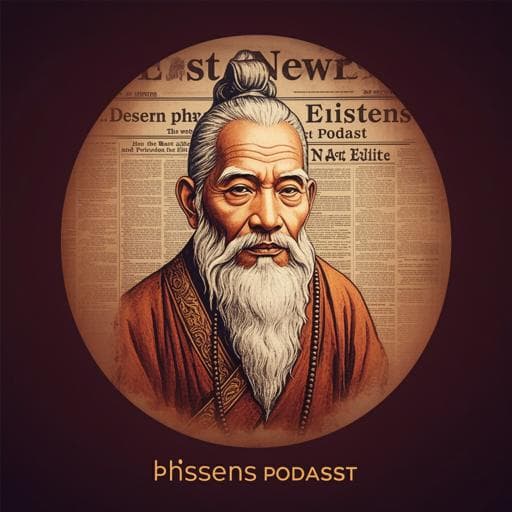
Humanities
Confucius in *The Times* from 1785 to 2019: a diachronic news discourse analysis of newsworthiness
C. Chen and R. Liu
Discover how Great Britain’s perception of Confucius has evolved from 1785 to 2019, as revealed by researchers Cheng Chen and Renping Liu. This study employs corpus linguistics to trace the shift from a Westernized image to one that embraces Chinese identity, concluding with powerful insights into elitism in representations. A compelling reflection on history and identity awaits!
~3 min • Beginner • English
Introduction
The study examines how the conception of Confucius has been constructed in British public discourse by analysing The Times from 1785 to 2019 through a discursive news values approach. Confucius, a fifth-century BCE Chinese thinker central to Chinese culture and influential in global intellectual history, has been variably idealized and criticized in the West. The authors argue that news values—criteria guiding journalists’ selection and construction of stories—mediate public perceptions. They pose three research questions: (1) How was Confucius defined and described in The Times from 1785 to 2019? (2) What news values were constructed by these definitions and descriptions? (3) How did these news values dominate diachronically? By focusing on Britain, historically a core of Western culture, the study explores how news discourse packaged and sold the ‘Confucius’ news entity to British audiences over 235 years, aiming to infer the evolution of British public cognition.
Literature Review
Prior research on Confucius in Britain largely centers on two domains: (a) analyses of English translations and adaptations of Confucian texts, typically focused on the late 18th to 19th centuries (e.g., St Andre, 2018; Bai, 2013; Murray, 2015; Zhen, 2022); and (b) studies of Confucius Institutes and Chinese language/culture promotion in contemporary Britain (e.g., Hua & Wei, 2014; Xiang, 2021; Li & Xue, 2022; Ye & Edward, 2018). These works often assume that Confucian texts and Institutes were the primary vectors of British engagement with Confucius, an assumption that may not hold in earlier historical periods. Moreover, most research uses a synchronic lens, offering limited historical comparison. In journalism and discourse studies, news values have been theorized as selection and construction criteria (Bell, 1991; Richardson, 2007) and further elaborated through the Discursive News Values Approach (DNVA) (Bednarek & Caple, 2012–2017), which treats news values as constructed through multimodal discourse and aligned with ideological positions. While DNVA has been applied in cross-cultural, synchronic analyses (e.g., Caple et al., 2020; Zhang & Caple, 2021), diachronic applications are scarce. This study addresses these gaps by applying DNVA to a 235-year diachronic corpus, testing assumptions about how British society encountered Confucius and how newsworthiness evolved.
Methodology
Data source: The diachronic corpus of The Times (1785–2019) in CQPweb (Lancaster University), comprising 24 decade-based subcorpora, 72,831 news texts, and 11,383,298,453 tokens. Rationale: The Times provides continuous daily coverage and an exhaustive searchable archive, making it suitable for diachronic analysis. Retrieval: Using CQPweb’s concordancer (functionally akin to AntConc), the authors searched for 'Confucius', 'Confucian', 'Confucianism', and 'Confucianist' to gather Confucius-centered instances for each decade and compiled 24 subcorpora. Analytical focus: Because relevant data were often short phrases/clauses rather than long articles, the analysis targeted collocations and concordance lines. Manual semantic categorization grouped instances into four sub-themes: (1) the person of Confucius; (2) works/theories of Confucius; (3) Confucius institutes; (4) followers of Confucius. Framework: DNVA with 10 news value categories (Consonance, Eliteness, Impact, Negativity, Positivity, Personalization, Proximity, Timeliness, Unexpectedness, Superlativeness) applied to written text (the relevant mode historically), with attention to culture-sensitivity of news values. Procedure: For each sub-theme, the authors identified recurrent strategies via collocations and interpreted how these strategies constructed newsworthiness, then tracked their diachronic distributions. They also contextualized shifts in news values alongside Sino–UK relations and historical events. Outputs include frequency tables for sub-themes and strategy distributions across decades.
Key Findings
1) Four sub-themes of Confucius references were identified: the person of Confucius; works/theories; Confucius institutes; followers of Confucius. In the earliest period (1780s–1830s), The Times first reported ‘the person of Confucius’ and ‘followers of Confucius’ before substantial attention to works/theories or institutes, challenging assumptions that Britons primarily encountered Confucius through texts or institutes prior to the 1830s. 2) Works/theories rose markedly from the 1840s onward and, together with the person of Confucius, remained dominant for 180 years. Example decade counts (Table 3): works/theories 203 (1990s) and 203 (2010s); person of Confucius 129 (2010s). Confucius institutes and followers remained low-frequency across the period. 3) The person of Confucius was framed via four strategies with diachronic shifts: (a) religionization (aligning Confucius with figures like Christ, Buddha, Mohammed) and (b) Westernization (paired with Aristotle, Shakespeare, Plato, etc.) dominated before the 1840s, constructing Eliteness and Proximity; (c) sinicization (foregrounding Chinese places, dynasties, family names) increased from the 1850s onward, elevating perceived foreignness; (d) depreciatization peaked in the 1970s (e.g., Cultural Revolution narratives), constructing Negativity. Strategy shares illustrate shifts (Table 5), e.g., 1970s: depreciatization 86%, sinicization 13%, minimal Westernization/religionization; 2000s–2010s: sinicization dominant (83–86%) with reduced Westernization/religionization (~7–9%). 4) Works/theories of Confucius consistently constructed Eliteness, reinforced by analogies to Western classics (e.g., Homer), to religious scriptures (e.g., Koran), and by quotations cited by Western elites (e.g., scholars, broadcasters), which also built Proximity. 5) Confucius institutes, although intrinsically elite (institutional/professional and often government-affiliated), appeared infrequently and were typically contextualized with Chinese governmental support, reinforcing Eliteness (e.g., Confucian Foundation of China, 1980s). 6) Followers of Confucius functioned metonymically for Chinese national identity. Before the 1890s, they were framed as ordinary people, constructing weak Personalization (nationality without individualized detail). From the 1890s to 1950s, Personalization and Eliteness coexisted; after the 1960s, followers were predominantly framed as elites (e.g., scholars, officials), shifting the construction from ordinariness to Eliteness (Table 7: post-1960s often 100% elite). 7) External socio-historical events influenced newsworthiness: the Opium War era coincided with increased sinicization; the Cultural Revolution drove Negativity in the 1970s; later decades reflected growing familiarity, with reduced Westernization/religionization and increased sinicization. 8) Methodologically, the study demonstrates DNVA’s applicability to diachronic, scattered textual data, revealing dynamic relations between discourse, news values, and societal cognition.
Discussion
The findings answer the research questions by showing how The Times defined Confucius via shifting strategies that constructed distinct news values over 235 years. Early Westernization and religionization framed Confucius as elite and proximate to British audiences, facilitating acceptability of a foreign cultural figure. As British familiarity with Confucius and China grew—particularly following 19th-century Sino–UK interactions—sinicization increased, foregrounding Chinese contexts while Westernization/religionization played a balancing role. The 1970s spike in depreciatization indicates that social events in China (Cultural Revolution) could directly shape news values (Negativity), highlighting that journalistic constructions respond both to audience alignment (acceptability, proximity) and to perceived authenticity when accommodating contemporaneous social realities. The metonymic use of ‘followers of Confucius’ to index Chinese nationality reveals an evolution from generalized ordinariness (weak personalization) to individuated elite personas (Eliteness), mirroring changing British cognitive frames about Chinese people—from undifferentiated masses to recognizable elites. These diachronic insights extend DNVA beyond synchronic snapshots, illustrating how evolving socio-political relations and historical events recalibrate news values and reporting strategies over time.
Conclusion
This study provides the first corpus-based diachronic DNVA of Confucius in British news, showing how The Times packaged Confucius across 235 years through shifting constructions of Eliteness, Proximity, Negativity, and Personalization. It challenges prevalent assumptions about the primary routes through which Britons encountered Confucius before the 1830s, supplies historical evidence on the metonymic framing of Chinese identity, and demonstrates DNVA’s utility for analyzing scattered historical references. The work contributes a historical perspective to news discourse studies and Confucianism research, offering a dataset and interpretive framework for understanding the localization of Confucianism in Britain. Future research should expand to other British newspapers and potentially multimodal resources to compare interpretative packages and to further trace how socio-historical dynamics shape newsworthiness over time.
Limitations
The analysis is limited to a single news outlet (The Times) and focuses on written text; comprehensive diachronic databases for other British newspapers were not available to the authors at the time. Broader cross-outlet comparisons may reveal different constructions of news values and alternate interpretive packages.
Related Publications
Explore these studies to deepen your understanding of the subject.







